It is surprising how so many wargamers have little idea of the "face of battle" to use the term currently in fashion, and the tactics used on battlefields. The tactics used by the Prussian army in the Wars of the French Revolution and the Napoleonic Era are equally misunderstood, perhaps all the more so because the reading of primary and secondary sources in the vernacular which is necessary to gain an insight into the subject is beyond the capabilities of virtually all wargamers and historians in the English-speaking world. I hope to make a small step towards ending this sorry situation with a series of essays on the subject.
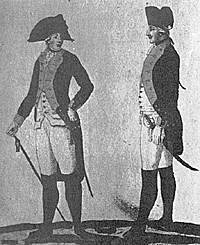 FUSILIER OFFICER & PRIVATE, 1789.
FUSILIER OFFICER & PRIVATE, 1789.
Source: Preussische Armee-Uniformen unter der Regierung Friedrich Wilhelm II Koenigs von Preussen. (Potsdam 1789). Photograph from Archiv Hofschroer.
Fusilier Battalions Uniform Colors
The picture we tend to have of the infantry of 1806 is one of dim-witted, rigid automata fighting in stiff, "Frederican" lines who were quickly baffled by hoardes of liberated French skirmishers and who were sent packing by these cunning Gallic sharpshooters long before the battle had really begun. Take for example what Petre wrote on the subject in his Napoleon's Conquest of Prussia - 1806 which is used as a standard source by most wargamers:
- When, in 1806, the precise linear tactics of Frederick came
into contact with the more mobile system of the French,
they failed absolutely. The Prussians to some extent
employed light troops as skirmishers, but they were rarely
strong enough to hold back the clouds of skirmishers,
constantly relieved and supported by small handy
columns, which formed Napoleon's fighting line. Again and
again it was proved how impossible it was to carry out,
under the fire of skirmishers adept in the art of utilising
eover, the solemn deployment and preparation of
Frederick's days. The men, incessantly harassed by fire
which they could not return with effect during their
deployment, were already half defeated before they were
ready to fight. (Page 22).
Here, Petre is talking in general terms. Later on in the same book, he is a good deal more specific:
- Harassed by a galling fire from the swarms of skirmishers
in and on either side of Vierzehnheiligen and unable to
return it, the Prussian infantry was already shaken and
demoralised before it was ready to begin volley firing.
(page 137)
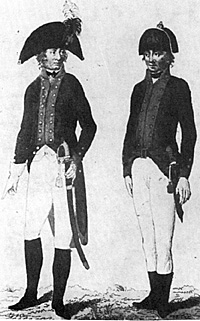 FUSILIER OFFICER & PRIVATE, 1800: Source: Tabellarische Nachweisung von alien Regimenter und Korps der koeniglich preussischen Armee. (Berlin 1800). Photograph - Archiv Hofschroer.
FUSILIER OFFICER & PRIVATE, 1800: Source: Tabellarische Nachweisung von alien Regimenter und Korps der koeniglich preussischen Armee. (Berlin 1800). Photograph - Archiv Hofschroer.
In 1795, Batt. von Stutterheim was raised, and in 1797, a further three battations, bringing the total to 24. A shorter jacket was introduced from 1797.
This is the 'traditional' view: the French tactics were far superior to those of the Prussians which were so out of date that the result of Jena and Auerstadt was a foregone conclusion. Later on, we shall examine the facts and see if an objective analysis of them does support Petre's and the 'traditionalists' view.
Furthermore, the picture we have of the Prussian army of 1813 is that of one that learned the lessons of 1806 and used even bigger clouds of skirmishers than the French and thus beat them at their own game. This view is eemplified by Peter Paret in his Yorck & the Era of Prussian Reform where he states:
- The armies of Europe thus reacted in different ways to the
stimulus of the French wars. Of them all, the Prussians paid
the closest attention to the technique of skirmishing and the
amalgamation of skirmishers and column; having once been
most deeply committed to the line, they now went farthest to
the opposite side. (Page 208)
Here we have an expression of the widely-held view of the Prussians of 1813 being better Frenchmen than the French. This too we will examine later on.
Prussian Line
First though, it is necessary to examine the concept of the Prussian line, its genesis and philosophy. To deal with these issues, we need initially to consider the tactics of the eighteenth century, the type of soldier that used them and how he was armed. This was the age of the standing army where the state now accepted responsibility for the training and upkeep of its armed forces where the burden of military service fell on the backs of the peasantry who were officered by the land-owning aristocracy, bound by oath to their monarch.
These soldiers were armed with an inaccurate, unreliable, smoothbore muzzle-loading weapon. The only way these weapons could have any noticable effect on the outcome of a battle was to concentrate them in mass, hence the use of close order tactics. Three ranks was the optimum depth for such formations as firing from any further ranks was difficult if not dangerous. Strict discipline was needed to maintain the formations and to execute volley firing. We thus had the age of the highy-drilled peasant-soldier, at times brutally treated by their aristocratic officers so as to perform the evolutions necessary to win battles.
Frederick the Great inherited such an army from his father and under his guidance it became the best in Europe, its armament, attacking and rate of fire being far superior to those of its opponents. His 'walking batteries simply outshot their enemies. Under Frederick's influence, linear tactics reach their zenith. He formed his army in two long lines, secured its flanks on an obstacle or with cavalry, advanced towards the enemy and defeated them in the firefight. There was no reserve to speak of, his men usually had only one chance to do their job. They had to be highly trained and strictly disciplined to achieve this and the three-deep line was the logical and most efficient way of using the flintlock musket - they won many battles with these tactics.
It was not only the constraints of technology that dictated the form of eighteenth century battles, but also those of the class system. Linear tactices were geared to the social relationship of the peasant-soldier to his aristocratic officer. With an ordered society, each class having its position and function, it was inevitable that the army would reflect the discipline and privileges of the society of which it was a part. The French Revolution broke through these restraints and created the citizensoldier.
Freed from these shackles, it was now possible to have a new type of warfare, one with a significant number of infantry in loose order, skirmishers, playing a role of limited importance on the field of battle. But this is only part of the story and other events caused an at times gradual, at times rapid change in infantry tactics. It was not just the effects of the French Revolution, either directly or indirectly through the experience of 1806 which were responsible for the changes in Prussian infantry tactics.
Influences
The influences on the evolution of Prussian infantry tactics after the Seven Years War were indeed manifold. The label of "Frederican" which is often put on the army of 1806 by those who know no better is indeed a laughable criticism in the light of Frederick's own writings on tactics and his modification thereof in his own lifetime. Take for instance his Military Testament of 1768 in which he states that in attacking strong positions:
- "I would give the first attack to the free battalions, I would have them move without order, spread out and skirmishing in order to draw the enemy's fire on themselves, the regular troops
may carry it out in better order."
Furthermore, in his "Principles of Tactics" of 1770, Frederick said that the Free-Battalions (light infantry) should:
- ...Without flinching from danger, go straight at the enemy to
draw his fire and perhaps to cause disorder in his ranks which
facilitates the second attack which advances closed and in
good order and thereby will have much less trouble dealing with
the enemy.
We can therefore see that Frederick himself was no advocate of the stiff, so called 'Fredrican' tactics which it is alleged that the army of 1806 used. Skirmishing was being considered in the Prussian army long before the French Revolution had even started, let alone before Jena and Aurstaedt.
The use of light infantry gained further consideration in Germany after the American War of Independence. German mercenaries were employed by the British Crown and many officers, especially the younger ones,, including the later reformer Gneisenau, were greatly influenced by their experiences in North America. This is a further influencing factor which affected German military thinking on skirmishing a decade before the French Revolution.
Further indications of this development are given in Volume III of Jany's history of the Prussian army. Here, he outlines the genesis of the light infantry in the Prussian army as a result of the experience of the Seven Years War. Further experience was gained in the War of the Bavarian Succession and subsequently various ideas on their organization and use were put forward.
Frederick the Great himself strengthened the Foot Jaeger to ten companies and founded three 'Free Regiments' (light infantry). These facts rather beg the question as to what 'Fredrican' tactics were. The men of the Free Regiments were trained to fight in villages, to guard the van, rear and flanks, to attack heights, gun batteries and works, to protect the baggage trains and winter quarters and to engage in small-scale actions - in short as proper light infantry. These troops were transformed in to the fusilier battalions of 1787.
Shortly after Frederick's death, the fusilier battalions were founded and consisted of four companies, each of 19 officers, 48 sargeants, 13 musicians (buglers and drummers), 80 corporals, 440 privates along with 40 surplus men, 1 accountant/quartermaster, 4 surgeons and 1 armourer. Then there were an additional 40 sharpshooters and, in wartime, a 3 pounder served by artillerymen. The wartime strength was therefore 680 combatants, 46 train soldiers, 4 artillery labourers and, with the 56 non-combatants, a total of 736 men. Note that these men were trained to fight in TWO ranks and not the customary three. The "More modern" French army did not attempt to introduce the two-rank formation until 1813. A total of ten such battalions were raised at this time.
In addition to these independently organised light infantry formations, there were the newly-founded sharpshooter sections of the line infantry companies. From 1787, each infantry company was to have 10 rifle-armed skirmishers. In the time of war, each infantry regiment, (two musketeer and one grenadier battalion) was to consist of 56 officers, 147 sargeants, 45 musicians, 51 gunners, 1800 privates (including 120 sharpshooters), a total of 2099 combatants. In 1793, the sharpshooters got their own bugler. What is apparent here is that well before the French Revolution, the Prussian army was developing its light infantry branch. In 1787 it was small. It continued to grow and develop throught the period we are examining.
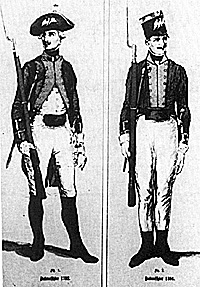 FUSILIER NON-COMMISSIONED OFFICERS, 1792 & 1806.
FUSILIER NON-COMMISSIONED OFFICERS, 1792 & 1806.
Source: Geschichte der Bekleiclung, Bewafnung und Ausruestung des Koeniglich
Preussischen Heeres by C. Kling (Weimar 1902 - 1912)
Fusilier Non-Com Uniform Colors
On February 26, 1789, the sharpshooters received a printed manual of arms and evolutions. This contained instructions on their training and tactical use. It formed the basis for their employment in the Wars of the French Revolution where they came into their own in the broken countryside of the Palatinate.
The fusilier battalions received their own regulations in 1788. Two platoons of the eight in each company were trained to fight in open order, a further two were allowed to join the skirmish line at discretion. Orders were given by means of horn signals. The fusiliers gave a good account of themselves, proved to be competent light infantry and were soon regarded as crack formations.
The combat formations of the line infantry according to the 1788 regulations were based around the line. The square was a hollow formation. The approach march was made in column. The marching speed was 108 paces per minute. One could view the emphasis on linear tactics as an anachronism or as being made out of date by the development in infantry tactics in the light of the wars of the French Revolution. We hear much about how as a result of the experience in 1806, the Prussian army virtually adopted the French regulations as their own. It is rarely pointed out that his is somewhat of an exaggeration as the French Regulations of 1791 were themselves based on the Prussian Regulations of 1788, so who was anachronistic and who was copying whom?
It should also be pointed out that the 1788 regulations were no 'tablets of stone' which had to be accepted without question. The development of infantry tactics from 1789 to 1806 was not ignored. In fact, one could say that too much attention was paid to the subject and that the infantry were over-burdened with innovations and changes in the regulations. This was a time of open discussion and free experimentation and the central documents which indicate this are: 1. The Instruction of 11th March 1798. 2. The New, Improved Instruction of 14th October 1802. 3. The Concise and Improved Regulations for all Regiments and Battalions of 30th December 1803.
In addition there was a number of Royal Decrees and further instructions issued at district and regimental level, including one on the use of the third rank of the line infantry as skirmishers. The period of peace from 1795 to 1806 was thus not characterised by the 'rigidity' which certain writers make great play of.
In 1799, a number of organisational changes took place. From then, every musketeer (line) battalion consisted of five companies. The field strength of each company was 120 privates, so a battalion consisted of 600 men, drawn up in a line three men deep. The grenadier companies were 150 men strong and four made up a battalion. The fusilier battalions consisted of 4 companies, each of 30 men, a total of 520 men. The musketeer battalions had 50 sharpshooters, the grenadiers and fusiliers 40. The fusiliers had lost their battalion guns and were armed with a shorter musket.
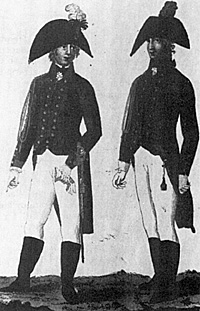 JAEGER - OFFICER & PRIVATE, 1800
JAEGER - OFFICER & PRIVATE, 1800
Source Tabellarische Nachweisung, (Berlin 1800)
The Jaeger were armed with hunting rifles and wore siskin green tunic with red
collars and cuffs, yellow buttons.
The column of march was four or five miles long and was deployed into a three deep line on the field of battle. The approach march could still be made at the speed of 75 paces per minute, with shouldered arms, but the taster 108 paces per minute was coming more into avour and was certainly always used when in proximity to the enemy. At this point, the musket was either taken in the left arm or sloped on the left.
When the advance came close to the enemy, the musket was first brought over to the right-hand side and just before the bayonet attack, it was charged. The fusiliers, fighting in just two ranks, used similar evolutions.
Skirmishing in front of the line of battle was carried out either by the fusilier battalions or the sharpshooter sections of the line battalions. Occasionally in the 1806 campaign, the third rank of the line battalions was used in a skirmish function and the practice of calling for volunteers from the line was also adopted.
There were two main errors in the use of skirmishers by the Prussians at this time. Firstly, there were too few of them and it was thus necessary to improvise as described above to increase their numbers. Secondly, the sharpshooters of the line battalions were often detached and used independently from their parent unit as there were two few fusilier battalions and they needed assistance. This resulted in the lines often having to face French skirmishers without adequate means to oppose them. It is interesting to note that the number of sharpshooters was increased by ten per company as from 23rd November 1806.
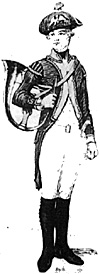 FUSILIER BUGLER, 1792
FUSILIER BUGLER, 1792
Source Kling.
A number of orders were conveyed to the fusiliers by means of horn calls.
To summarise the central points established so far:
- 1. There was no such thing as rigid "Frederican" tactics as Frederick's tactics developed throughout his reign and afterwards.
2. That being the case, the Prussian army of 1806 could not have fought in stiff 'Frederican' formations as there was no such thing.
3. Light infantry tactics developed in the course of Prussian military history, especially from 1764 to 1806. The influence of the French Revolutionary Wars is thus not as great as some writers maintain.
The picture we have so far of Prussian infantry tactics of 1806 is one centered around battalion lines to a greater or lesser extent supported by skirmishers and with the battalion guns placed according to circumstances, the intention of these lines being to defeat the enemy with their far superior firepower. In the next part of this essay, I propose to examine how the various tactical aspects worked in practice.
More Prussian Infantry
-
Part 1: End of Frederick The Great's Reign to the Campaign of 1806
Part 2: Tactical Aspects of the 1806 Campaign
Back to Table of Contents -- Courier Vol. III #5
To Courier List of Issues
To MagWeb Master Magazine List
© Copyright 1982 by The Courier Publishing Company.
This article appears in MagWeb (Magazine Web) on the Internet World Wide Web.
Other military history articles and gaming articles are available at http://www.magweb.com